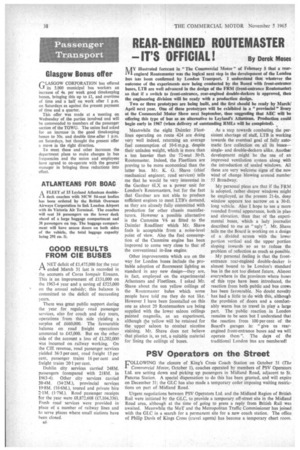REAR-ENGINED ROUTEMASTER
Page 40

If you've noticed an error in this article please click here to report it so we can fix it.
-IT'S OFFICIAL! By Derek Moses NAY illustrated forecast in "The Commercial Motor" of February 5 that a rear1V1 engined Routemaster was the logical next step in the development of the London bus has been confirmed by London Transport 1 understand that whatever the outcome of the experiments now being conducted by the Board with front-entrance buses, LTB are well advanced in the design of the FRM (front-entrance Routemaster) so that if a switch to front-entrance, rear-engined double-deckers is approved, then the engineering division will be ready with a production design.
Two or three prototypes are being built, and the first should be ready by March/ April next year. One of these prototypes will be exhibited in a "provincial livery at the Commercial Motor Show next September, thus suggesting that ABC will be offering this type of bus as an alternative to Leyland's Afiantean. Production could begin early in 1967 (when delivery of outstanding RMLs will he completed).
Meanwhile the eight Daimler Fleetlines operating on route 424 are doing very well indeed, returning an average fuel consumption of 10.6 m.p.g. despite their unladen weight, which is more than a ton heavier than the 72-seat 30-ft. Routemaster. Indeed, the Fleetlines are proving to be more economical than the latter bus. Mr. K. G. Shave (chief mechanical engineer, road services) tells me that he would be very interested in the Gardner 6LX as a power unit for London's Routemasters, but for the fact that Gardner are not able to produce sufficient engines to meet LTB's demand, as they are already fully committed with production for other chassis manufacturers. However a possible alternative is the Cummins V6 as fitted to the Daimler Roadliner which Mr. Shave feels is acceptable from a noise-level point of view. Also the fuel consumption of the Cummins engine has been improved to come very close to that of the. conventional in-line engine.
Other improvements which are on the way for London buses include the probable adoption of fluorescent lighting as standard in any new design—they are, in fact, employed on the experimental Atlanteans and Fleetlines. I asked Mr. Shave about the sun yellow ceilings of the Routemaster buks which some people have told me they do not like. However I have been forestalled on this one as about 20 Rontemasters are being supplied with the lower saloon ceilings painted magnolia, as an experiment, although the yellow will be retained for the upper saloon to combat nicotine staining, Mr. Shave does not believe that plastics is, as yet, a suitable material for lining the ceilings of buses.
As a step towards combating the persistent shortage of staff, LTB is working towards the eventual goal of fully automatic fare collection an all its buses— singleand double-deckers alike. Another development might be the use of an improved ventilation system along with the introduction of sealed windows. All these are very welcome signs of the new wind of change blowing around number 55 Broadway.
My personal pleas are that if the. FRM is adopted, rather deeper windows might be employed, as the present 21-in, deep window appears too narrow on a 30-ft. long vehicle. Also I hope to see a more rounded frontal appearance, both in plan and elevation, than that of the experimental buses, which a lady journalist described to me as "ugly ", Mr. Shave tells me the Board is working on a design of a divided screen with the lower portion vertical and the upper portion sloping inwards so as to reduce the problem of reflection as much as possible.
My personal feeling is that the frontentrance rear-engined double-decker is almost bound to be London's standard bus in the not too distant future. Almost everywhere in the provinces where buses of this type have been introduced, the reaction from both public and bus crews has been favourable. No doubt novelty has had a little to do with this, although the provision of doors and a comfortably warm bus to travel in play a large part. The public reaction in London remains to be seen but I understand that the reaction from 100 per cent of the Board's garages is: "give us rearengined front-entrance buses and we will operate them ". The days of the traditional London bus are numbered!




















































































































